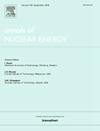Analysing hydrogen behaviour in liner claddings using OFFBEAT fuel performance code
IF 1.9
3区 工程技术
Q1 NUCLEAR SCIENCE & TECHNOLOGY
引用次数: 0
Abstract
Hydrogen generated during the waterside corrosion of zirconium claddings can diffuse within the material, forming hydrides that alter the mechanical properties of the claddings. These hydrides may lead to detrimental effects such as delayed hydride cracking and embrittlement, compromising the integrity of the claddings. Liner claddings, which have been particularly used in Swiss reactors, have been shown to aid in minimizing these detrimental effects of hydrogen behaviour on zirconium claddings. In this paper, hydrogen behaviour models for liner claddings have been incorporated into the multi-dimensional, thermo-mechanical fuel performance code, OFFBEAT. Numerical analyses using OFFBEAT are then compared to out-of-pile experimental data on two liner cladding types commonly used in Swiss reactors. The findings indicate that OFFBEAT’s predictions closely align with experimental observations, demonstrating hydrogen migration toward the substrate-liner interface (SLI). This research confirms OFFBEAT’s capability to simulate hydrogen behavior in liner claddings, supporting further exploration of alternative cladding configurations moving forward towards more advanced technological fuels for nuclear safety.
用OFFBEAT燃料性能代码分析班轮包壳中的氢行为
锆包层在水边腐蚀过程中产生的氢可以扩散到材料内部,形成氢化物,改变包层的机械性能。这些氢化物可能导致有害的影响,如延迟氢化物开裂和脆化,损害包层的完整性。在瑞士反应堆中特别使用的衬里包覆层,已被证明有助于减少氢对锆包覆层的这些有害影响。在本文中,内衬包壳的氢行为模型已被纳入多维,热机械燃料性能代码,OFFBEAT。然后将OFFBEAT的数值分析与瑞士反应堆常用的两种衬里包层的堆外实验数据进行了比较。研究结果表明,OFFBEAT的预测与实验观察结果密切一致,证明了氢向衬底-衬里界面(SLI)的迁移。这项研究证实了OFFBEAT能够模拟氢气在内衬包层中的行为,支持进一步探索替代包层结构,朝着更先进的核安全技术燃料的方向发展。
本文章由计算机程序翻译,如有差异,请以英文原文为准。
求助全文
约1分钟内获得全文
求助全文
来源期刊

Annals of Nuclear Energy
工程技术-核科学技术
CiteScore
4.30
自引率
21.10%
发文量
632
审稿时长
7.3 months
期刊介绍:
Annals of Nuclear Energy provides an international medium for the communication of original research, ideas and developments in all areas of the field of nuclear energy science and technology. Its scope embraces nuclear fuel reserves, fuel cycles and cost, materials, processing, system and component technology (fission only), design and optimization, direct conversion of nuclear energy sources, environmental control, reactor physics, heat transfer and fluid dynamics, structural analysis, fuel management, future developments, nuclear fuel and safety, nuclear aerosol, neutron physics, computer technology (both software and hardware), risk assessment, radioactive waste disposal and reactor thermal hydraulics. Papers submitted to Annals need to demonstrate a clear link to nuclear power generation/nuclear engineering. Papers which deal with pure nuclear physics, pure health physics, imaging, or attenuation and shielding properties of concretes and various geological materials are not within the scope of the journal. Also, papers that deal with policy or economics are not within the scope of the journal.
 求助内容:
求助内容: 应助结果提醒方式:
应助结果提醒方式:


